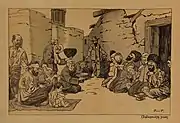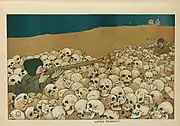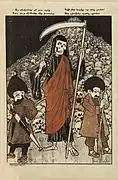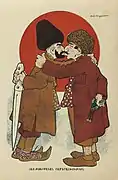Khatabala
Khatabala (Armenian: Խաթաբալա; Russian: Хатабала) was a twelve-page Armenian satirical periodical published in Tiflis (Tbilisi) from 1906 to 1916 and again in 1922 and 1925–26[1] in the Armenian and occasionally Russian and Georgian languages. It was founded by Astvatsatur Yeritsyan (1872–?)[2][3], who edited the periodical along with Ashot Atanasyan (1870–1941). The name of Khatabala comes from a popular word used by Armenians, Georgians, Azerbaijanis and Persians meaning misfortune, setback, or troubles, ultimately derived from the Arabic words ḵaṭā (Arabic: خطأ, lit. 'error') and balāʾ (Arabic: بَلَاء, lit. 'trouble, tribulation').[4]
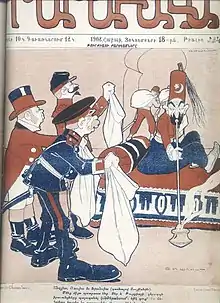 Khatabala #43 (c. 1908) | |
| Editor-in-chief |
|
|---|---|
| Staff writers |
|
| Categories | Satire |
| Founder | Astvatsatur Yeritsyan |
| Founded | 1906 |
| Final issue | 1926 |
| Based in | Tiflis (Tbilisi) |
| Language | |
History
Astvatsatur Yeritsyan[1][5][6] was a publicist and satirist. He was originally from Tsgnet[2] (Tskneti in Georgian). He received his primary education at the Nersisian School in Tiflis, then studied at the St. Petersburg Conservatory, but dropped out and returned to Tiflis. Here, in 1906, he firstly published the Russian-language magazines[7] Zhgut (only one issue was published[8]) and Svistok (only two issues were published[9]), and later, in the company of a prominent democrat and publicist Ashot Atanasyan, he founded the satirical periodical Khatabala. In 1909–1912 Astvatsatur Yeritsyan also edited and published the literary, political and commercial daily Surhandak.[2]
The main purpose of the magazine was to satirically depict various social phenomena, such as inequality, cultural assimilation and corruption, and to ridicule backward lifestyles and values of the clergy and bureaucrats. Khatabala harshly condemned the anti-Armenian policy of the Ottoman Empire and championed the friendship of the peoples of Transcaucasia. It contained frequent responses to international events, and traced the liberation struggle of the peoples of the Balkans and the East.[1] Its repeated solidarity with Azerbaijani satirical magazine Molla Nasraddin gained widespread attention.[6][10][11] It is a visually stunning and extremely rich source on the life of Armenians in early twentieth-century Tiflis, Constantinople, and beyond, and an important response to the repressive anti-Armenian policies of the Ottoman Empire and, in later years, the Armenian genocide.[12] During the First World War, it was published in the Armenian and Russian languages and was closed in 1916.
It was revived twice during the Soviet era. Only one issue was published in 1922, and a total of 7 issues were published in 1925–1926.[13] Khatabala differed from Karmir Motsak (another Armenian satirical periodical published in Tiflis) in its breadth of coverage of reality, the richness of factual material, and the color of artistic creativity. The publication affirmed the socialist doctrine while also criticising the undesirable features of reality and pitting two socialist and capitalist moral worlds against one another.[5] However, the number of issues in these publications was drastically reduced, and the humor's tone and storyline changed. Khatabala also stopped publishing along with such satirical periodicals Shesht, Zurna, Karmir Motsak as a result of censorship.[14] In the last years of its publication, it was published in the Armenian, Georgian and Russian languages.
Contributors
Among its contributors were Gevorg Bashinjaghian, Henryk Hryniewsky, Garegin Yeritsyan, A. Mirzoyan, Josef Rotter, Atrpet, Musheg Bagratuni, Tmblachi Khachan, Garegin Levonyan, Hovhannes Tumanyan (1869–1923, considered the Armenian national poet), Avetik Isahakyan (1875–1957, a well-known Armenian poet), Movses Arazi, Stepan Zoryan.[1] A number of the illustrations were also painted by Oskar Schmerling (1876–1938), the Georgian painter and graphic artist of German origin,[15] who taught Lado Gudiashvili and other leading modernist artists.[12]
Gallery
- Cover pages
.jpg.webp) Cover of the first issue from 1906
Cover of the first issue from 1906 Cover from 1908
Cover from 1908 Cover from 1910
Cover from 1910
- Internal affairs
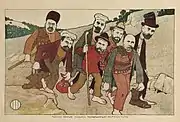 The victorious return of the Caucasian deputies of the State Duma
The victorious return of the Caucasian deputies of the State Duma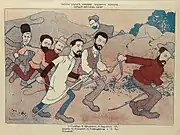 The victorious return of the Caucasian deputies of the State Duma of the Second Convocation
The victorious return of the Caucasian deputies of the State Duma of the Second Convocation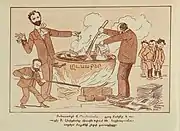 Hovhannes Tumanyan pours salt, Levon Shant stirs the fire, Stepan Lisitsian mixes the contents of the pot with one hand, adds Hasker numbers with the other to Lusaber, mother tongue textbook.
Hovhannes Tumanyan pours salt, Levon Shant stirs the fire, Stepan Lisitsian mixes the contents of the pot with one hand, adds Hasker numbers with the other to Lusaber, mother tongue textbook. Mullah for Azerbaijanis and Vdak leaders for Armenians are calling for a boycott of Molla Nasreddin and Khatabala respectively
Mullah for Azerbaijanis and Vdak leaders for Armenians are calling for a boycott of Molla Nasreddin and Khatabala respectively
External links
References
- Հայկական Սովետական Հանրագիտարան (Soviet Armenian Encyclopedia) (in Armenian). Vol. IV. p. 703.
- Նազարյան, Ս. Ս. (2000). "Արևելահայ երգիծական մամուլի պատմությունից (1906–1915) [From the history of East-Armenian satirical press (1906–1915)]". Herald of the Social Sciences Լրաբեր հասարակական գիտությունների (in Armenian). ՀՀ ԳԱԱ. 1: 149.
- Israelian, Sargis. "Pages From My Diary" (PDF). Duty of Soul (journal). Yerevan (6 April-June): 48.
- Berberian, Houri (2019). Roving Revolutionaries: Armenians and the Connected Revolutions in the Russian, Iranian, and Ottoman Worlds. University of California Press. p. 226. ISBN 978-0-520-27894-3. OCLC 1101650331.
- Իշխանյան, Ս. Թ. (1961). 20-ական թվականների հայ երգիծական մամուլը [Armenian satirical press of the 20s]. Bulletin of the Academy of Sciences of the Armenian SSR: Social Sciences ՀՍՍՌ ԳԱ Տեղեկագիր հասարակական գիտությունների (in Armenian). 10: 43.
- Իշխանյան, Ս. Թ. (1968). "Հասարակության կյանքում երգիծանքի դերի մասին (On the role of satire in society)". Լրաբեր հասարակական գիտությունների =Herald of the Social Sciences (in Armenian). ՀՍՍՀ ԳԱ. 6: 67.
- "Bagrat Yeritsian". Beyond Caricature (The Oskar Schmerling Digital Archive).
- "Жгут: [Иллюстрированный журнал политической сатиры]. - Тифлис, 1906". Электронная библиотека ГПИБ России.
- "Свисток: [Еженедельный художественно-сатирический журнал]. - Тифлис, 1906". Электронная библиотека ГПИБ России.
- Musée d'histoire contemporaine (1991). Russie-URSS 1914-1991 : changement de regards: [exposition, Paris, Musée d'histoire contemporaine de la Bibliothèque de documentation internationale contemporaine, 17 octobre-29 décembre 1991]. Wladimir Berelowitch, Laurent,. Gervereau, Impr. A. Nory). Nanterre: BDIC. p. 45. ISBN 2-901658-17-2. OCLC 708322271.
- Marc Ferro; Martine Godet; Muriel Carduner-Loosfelt; Hélène Coq-Lossky; Jacques Le Goff, eds. (1995). De Russie et d'ailleurs : feux croisés sur l'histoire: pour Marc Ferro. Paris: Institut d'études slaves. p. 95. ISBN 2-7204-0311-3. OCLC 214948269.
- "Խաթաբալա, e.g. Khatabala [Trouble], complete runs for 1907 (nos. 1-50) and 1912 (nos. 1-50). Yeritsian, A. and A. Atanasian, editors". Bernett Penka Rare Books.
- "ხათაბალა : [2] Collection home page". National Parliamentary Library of Georgia.
- Սուքիասյան, Համո Կարենի; Երանոսյան, Նարինե (2018). Խորհրդային Հայաստանի երգիծական մամուլը 1920-ական թվականներին (in Armenian). Yerevan: Ēditʻ Print. ISBN 9789939752860.
- "Oskar Schmerling". Beyond Caricature (The Oskar Schmerling Digital Archive).
